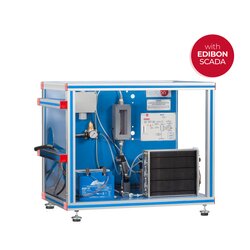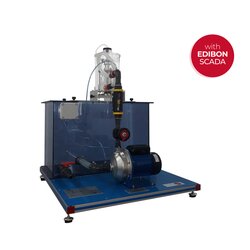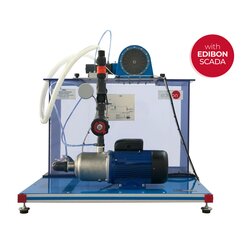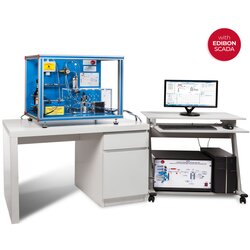Photovotaic Systems Application in Isolated and Parallel Grids (AEL-PHIP)
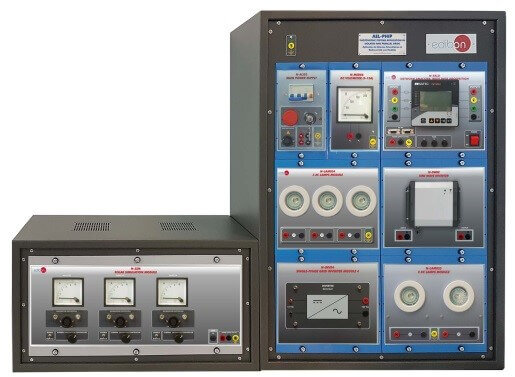

PL-919251
The "AEL-PHIP" Photovoltaic Systems Application in Isolated and Parallel Grids, developed by EDIBON, is designed for examining the operations of photovoltaic systems in both isolated (island mode) and grid-connected (parallel mode) configurations. This application allows users to explore electricity generation using photovoltaic panels by simulating various setups and irradiance conditions. It facilitates the study of both independent operation and grid-integration of photovoltaic systems, providing insight into the principles of control, regulation, and energy storage devices commonly utilized in real-world applications.
The "AEL-PHIP" application includes specialized kits, each offering a unique focus on specific aspects of photovoltaic power plants:
- PHIP-K1: Analysis of Series and Parallel Photovoltaic Modules Kit.
- PHIP-K2: Off-Grid Single-Phase Photovoltaic Systems Kit.
- PHIP-K3: Single-Phase Photovoltaic Systems for Parallel to Grid Operation Kit.
This modular approach allows students to gain a comprehensive understanding of photovoltaic system configurations, control mechanisms, and performance under both isolated and grid-connected conditions.
- AEL-PHIP. Unit:
- N-ALI02. Domestic Main Power Supply Module.
- PESS. Photovoltaic Module with Solar Path Simulation.
- N-EAL-DC. DC Network Analyzer Unit.
- N-REV01. Single-Phase Variable Resistor Module 0-700 Ohm.
- N-SSM. Solar Simulation Module.
- BAT6. Lead-Acid Battery 6.
- N-MED85. DC Ammeter (-6+6A).
- N-MED86. DC Voltmeter (0-15 V).
- N-REG02. Current Electronic Regulator Module 2.
- N-SWIN. Sine Wave Inverter.
- N-EALD. Network Analyzer Module with Oscilloscope and Data Acquisition.
- N-LAM34. 3 AC Lamps Module.
- N-LAMP35. 2 DC Lamps Module.
- N-INV04. Single-Phase Grid Inverter Module 4.
- All necessary cables to realize the practical exercises are included.
- Cables and Accessories, for normal operation.
- Manuals: This unit is supplied with 8 manuals. Required services, Assembly and Installation, Interface and Control software, Starting-up, Safety, Maintenance, Calibration and Practices manuals.
EXERCISES AND PRACTICAL POSSIBILITIES TO BE DONE WITH THE MAIN ITEMS
Practical possibilities with the PHIP-K1 kit:
- Daily and yearly curves display.
- Calculation of the photovoltaic modules optimal position.
- Display of the photovoltaic modules characteristic curves.
- Working of bypass diodes.
- Series and parallel configuration of the photovoltaic modules.
- Analysis of the simulated generation with different configurations of the photovoltaic modules and different solar irradiation conditions.
Practical possibilities with the PHIP-K2 kit:
- Installation of photovoltaic plants.
- Measuring the electrical parameters of the photovoltaic generation system.
- Designing and testing a photovoltaic system isolated from the grid in direct operation.
- Designing and testing a photovoltaic system isolated from the grid in storage operation.
- Designing and testing a photovoltaic system isolated from the grid with AC voltage supply and energy storage.
Practical possibilities with the PHIP-K3 kit:
- Installation of photovoltaic plants.
- Measuring the electrical parameters of the photovoltaic generation system.
- Designing and testing grid-connected (or parallel) photovoltaic systems.
- Determining the industrial inverter efficiency.
- Analysis of the photovoltaic system response to a grid blackout.
- Several other exercises can be done and designed by the user.
What is this?
These percentage scores are an average of 0 user reviews. To get more into detail, see each review and comments as per below
If you have used this product, support the community by submitting your review
